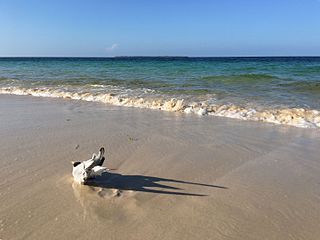
Dar es Salaam is the largest city and financial hub of Tanzania. It is also the capital of the Dar es Salaam Region. With a population of over eight million people, Dar es Salaam is the largest city in East Africa and the sixth-largest in Africa. Located on the Swahili coast, Dar es Salaam is an important economic center and one of the fastest-growing cities in the world.

Arlington National Cemetery is one of two cemeteries in the United States National Cemetery System that are maintained by the United States Army. Nearly 400,000 people are buried in its 639 acres in Arlington County, Virginia.

Dar es Salaam Region is one of Tanzania's 31 administrative regions and is located in the east coast of the country. The region covers an area of 1,393 km2 (538 sq mi). The region is comparable in size to the combined land and water areas of the nation state of Mauritius Dar es Salaam Region is bordered to the east by Indian Ocean and it is entirely surrounded by Pwani Region. The Pwani districts that border Dar es Salaam region are Bagamoyo District to the north, Kibaha Urban District to the west, Kisarawe District to the south west and Mkuranga District to the south of the region. The region's seat (capital) is located inside the ward of Ilala. The region is named after the city of Dar es Salaam itself. The region is home to Tanzania's major finance, administration and industries, thus the making it the country's richest region. The region also has the second highest Human Development Index in the country after Mjini Magharibi. According to the 2022 census, the region has a total population of 5,383,728 and national census of 2012 had 4,364,541. The region has the highest population in Tanzania followed by Mwanza Region.

Kinondoni District, officially the Kinondoni Municipal Council is one of five districts of the Dar es Salaam Region of Tanzania. The district is bordered to the north by Bagamoyo District and Kibaha of Pwani Region, to the east by the Indian Ocean, the west by Ubungo District, and to the south by the Ilala District. The district covers an area of 269.5 km2 (104.1 sq mi). The district is comparable in size to the land area of Malta. The administrative seat is Ndugumbi. The district is home to one of the best preserved Medieval Swahili settlements, Kunduchi Ruins, headquarters for the National Muslim Council of Tanzania (BAKWATA) and Makumbusho Village Museum. Considered the cultural center of Dar es Salaam, Kinondoni District is also regarded the birthplace of the musical genre of Singeli. In addition the district is one of two districts in Dar es Salaam that has a National Historic Site, namely the Kunduchi Ruins.The 2012 National Tanzania Census states the population for Kinondoni as 1,775,049.

Ilala District, officially the Ilala Municipal Council is one of five districts of the Dar es Salaam Region of Tanzania. The district is bordered to the north and northeast by Kinondoni District and Ubungo District, to the east by the Zanzibar Channel, the west by Pwani Region, and to the south by the Temeke District. It covers an area of 364.9 km2 (140.9 sq mi). The district is comparable in size to the land area of U.S Virgin Islands. The administrative seat is Mchafukoge. The 2012 National Tanzania Census states the population for Ilala as 1,220,611.

Ubungo District, officially the, Ubungo Municipal Council is one of five districts of the Dar es Salaam Region of Tanzania. The Kinondoni District and Kibaha of the Pwani Region border the district to the north; the Kisarawe District of Pwani Region borders it to the west; and the Ilala District borders the it to the south and east. The district covers an area of 269.4 km2 (104.0 sq mi). The district is comparable in size to the land area of St. Kitts and Nevis. The administrative seat is Kwembe. The district is home to the University of Dar es Salaam, The Magufuli Bus Terminal, the largest in the country, and Pande Game Reserve the largest protected land area in Dar es Salaam Region. In addition, the district is home to the largest natural gas powered power station, the Ubungo Thermal Power Station and the headquarters of the Tanzania Electric Supply Company Limited (TANESCO). The 2012 National Tanzania Census states the population of the district as 845,368.

Bongoyo Island is a protected, uninhabited island under the Dar es Salaam Marine Reserve with the IUCN category II located within Kinondoni District of Dar es Salaam Region in Tanzania. The island situated 2.5 km north of the country's largest city, Dar es Salaam in the Sea of Zanj. It is the most frequently visited of the four islands of the Dar es Salaam Marine Reserve System (DMRS) and a popular daytrip for both tourists and Tanzanian residents alike for snorkelling and sunbathing. North of the island is Mbudya Island and to the west is Pangavini Island. The island is home to some of Tanzania's largest specimens of endangered coconut crabs.

The Dar es Salaam Marine Reserve System or DMRS is a group of marine reserves in Tanzania, with the IUCN category II located within Dar es Salaam Region of Tanzania. The reserve system consists of nine uninhabited islands, four located north of Dar es Salaam's Kinondoni District; and four south of the city Makatumbi Islands, Kimbubu Island, Sinda Island and Kendwa Island in Kigamboni District. It provides protection for several important tropical ecosystems; coral reefs, mangroves and seagrass beds.
Hananasif also spelled, Hana Nasif is an administrative ward in Kinondoni District of the Dar es Salaam Region in Tanzania. The ward is surrounded to the north by the wards of Kinondoni and Msasani. The ward is bordered to the east by Kivukoni and Upanga West of Ilala MC. The ward is bordered by Mwanayamala to the west and Magomeni to the south. The ward is home to the well-known Kinondoni Cemetery, where notable figures like Herman Lupogo, Steve Kabyumba, and Josina Machel are interred. The ward is home to the Embassy of Russia and the Embassy of Switzerland. According to the 2012 census, the ward has a population of 37,115.

Kinondoni is an administrative ward in the Kinondoni District of the Dar es Salaam Region in Tanzania. The ward is bordered to the east by Mikocheni and Mwananyamala wards, to the west by Hananasif ward, and to the north by Msasani ward. The ward is home to the headquarters for the National Muslim Council of Tanzania (BAKWATA) with its grand Mosque. The ward is also the heaquarters of Tanzania's second largest political party Chadema. According to the 2012 census, the ward has a total population of 21,239.

Makurumla is an administrative ward in Ubungo District of the Dar es Salaam Region in Tanzania. The Kinondoni Municipal District's Ndugumbi ward borders the ward on the north. Mzimuni Ward to the east, Mburahati and Mabibo to the south were its neighbors. Lastly, via Manzese ward towards the west. In 2016 the Tanzania National Bureau of Statistics report there were 79,331 people in the ward, from 63,352 in 2012.

Mzimuni is an administrative ward in Kinondoni District of the Dar es Salaam Region in Tanzania. The ward's northern boundaries are formed by the wards of Ndugumbi and Magomeni. Upanga West and Jangwani wards of Ilala MC surround the ward on the east, and Kigogo ward borders it on the south. The Makurumla and Mburahati wards of Ubungo MC are to the west. The ward is home to the Mwalimu Nyerere Memorial House. In 2016 the Tanzania National Bureau of Statistics report there were 26,905 people in the ward, from 21,486 in 2012.

Ndugumbi is an administrative ward and district capital of the Kinondoni District of the Dar es Salaam Region in Tanzania. Tandale and Makumbusho ward border the ward to the north, Mzimuni to the east, Makurumla to the south and Manzese on the west. The last two being located in Ubungo District. In 2016 the Tanzania National Bureau of Statistics report there were 46,134 people in the ward, from 36,841 in 2012.

Ilala or Ilala Ward is an administrative ward of the Ilala District of the Dar es Salaam Region in Tanzania. The Kigogo ward of the Kinondoni District borders the ward to the north, and the Mchikichini and Gerezani wards to the east. The Temeke District wards of Keko, Chang'ombe, and Temeke border the ward to the south. Buguruni encircles the ward to the west. In 2016 the Tanzania National Bureau of Statistics report there were 38,923 people in the ward, from 31,083 in 2012.

Ardhi University also known as ARU is a public university located in Makongo in Kinondoni District of Dar es Salaam Region, Tanzania. It was established 28 March 2007, though it has been offering training for more than 60 years in different status. It is situated on Observation Hill close to University of Dar es Salaam, in which it was a constituent college from 1996 to 2007, when it was known as University College of Lands and Architectural Studies—UCLAS. Prior being part of University of Dar es Salaam, Ardhi University was known as Ardhi Institute with history extending to mid-1950s.

The Askari Monument or Dar es Salaam African Memorial in Kivukoni Ward in Ilala District of Dar es Salaam, Tanzania, is a memorial to the askari who fought in the British campaign against the German Army in East Africa in World War I. It was unveiled in 1927. The monument is located at the centre of a roundabout on Samora Avenue at the perpendicular junction to Maktaba Street and Azikiwe Street, a place that reportedly also marks the exact centre of downtown Dar es Salaam.

St. Joseph University In Tanzania (SJUIT) is a Private University in Tanzania. The University has two campuses at Mbezi Luguruni, Ubungo District and Boko Dovya Kinondoni District in Dar es Salaam, Tanzania. The main campus is at Mbezi Luguruni, Dar es Salaam.
Paul Christian Makonda is the Former Regional Commissioner of Dar es Salaam, Tanzania. He is the current secretary for ideology and publicity for Chama Cha Mapinduzi, a Tanzania ruling political party.
Herman Cornel Lupogo was a Tanzanian military officer and government administrator. After graduating from Makerere University, he enlisted in the Tanzania People's Defence Force in 1965. He held various positions in the army, including head of the National Leadership Academy, and served as a brigadier during the Uganda–Tanzania War of 1978 and 1979. He retired with the rank of major general in 1992, and subsequently worked as a government administrator. He chaired the Tanzania Commission for AIDS from 2001 until 2007, and died in 2014.
Leila Sheikh or Sheikh-Hashim was a Tanzanian journalist, women's rights activist and blogger. She was a founder member of Tanzania Media Women's Association (TAMWA) and became TAMWA's Executive Director in 1996.
















